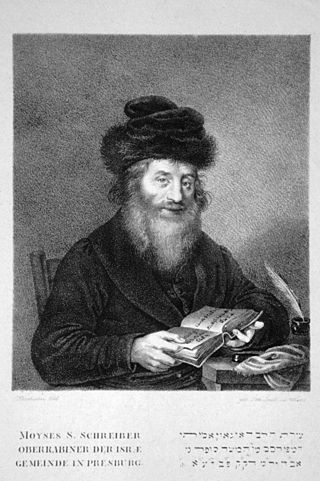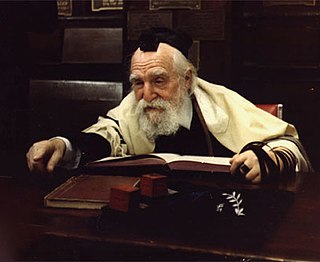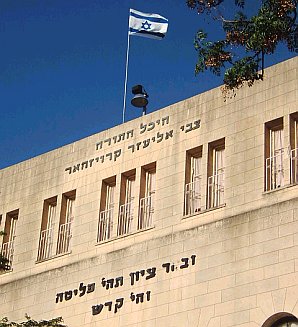Related Research Articles

Orthodox Judaism is the collective term for the traditionalist branches of contemporary Judaism. Theologically, it is chiefly defined by regarding the Torah, both Written and Oral, as revealed by God to Moses on Mount Sinai and faithfully transmitted ever since.
Modern Orthodox Judaism is a movement within Orthodox Judaism that attempts to synthesize Jewish values and the observance of Jewish law with the modern world.

Joseph Ber Soloveitchik was a major American Orthodox rabbi, Talmudist, and modern Jewish philosopher. He was a scion of the Lithuanian Jewish Soloveitchik rabbinic dynasty.

Agudath Israel of America is an American organization that represents Haredi Orthodox Jews. It is loosely affiliated with the international World Agudath Israel. Agudah seeks to meet the needs of the Haredi community, advocates for its religious and civil rights, and services its constituents through charitable, educational, and social service projects across North America.

Aharon Kotler was an Orthodox Jewish rabbi and a prominent leader of Orthodox Judaism in Lithuania and the United States; the latter being where he founded Beth Medrash Govoha in Lakewood Township, New Jersey.

Ner Israel Rabbinical College, also known as NIRC and Ner Yisroel, is a Haredi yeshiva in Pikesville, Maryland. It was founded in 1933 by Rabbi Yaakov Yitzchok Ruderman, a disciple of Rabbi Nosson Tzvi Finkel, dean of the Slabodka yeshiva in Lithuania. Rabbi Aharon Feldman, a disciple of Rabbi Ruderman and a member of the Moetzes Gedolei HaTorah of America, became its head in 2001.

Moses Schreiber (1762–1839), known to his own community and Jewish posterity in the Hebrew translation as Moshe Sofer, also known by his main work Chatam Sofer, Chasam Sofer, or Hatam Sofer, was one of the leading Orthodox rabbis of European Jewry in the first half of the nineteenth century.
World Agudath Israel, usually known as the Aguda, was established in the early twentieth century as the political arm of Ashkenazi Torah Judaism. It succeeded Agudas Shlumei Emunei Yisroel in 1912. Its base of support was located in Eastern Europe before the Second World War but, due to the revival of the Hasidic movement, it included Orthodox Jews throughout Europe. Prior to World War II and the Holocaust, Agudath Israel operated a number of Jewish educational institutions throughout Europe. After the war, it has continued to operate such institutions in the United States as Agudath Israel of America, and in Israel. Agudath Israel is guided by its Moetzes Gedolei HaTorah in Israel and the USA.

Yeshiva Torah Vodaas is a yeshiva in the Flatbush neighborhood of Brooklyn, New York.
Rabbi Isaac Elchanan Theological Seminary is the rabbinical seminary of Yeshiva University (YU). It is located along Amsterdam Avenue in the Washington Heights neighborhood of Manhattan, New York City.

Torah Umesorah – National Society for Hebrew Day Schools is an Orthodox Jewish educational charity based in the United States that promotes Torah-based Jewish religious education in North America by supporting and developing a loosely affiliated network independent private Jewish day schools.

Moshe Shatzkes was a rabbi and Talmudic scholar, commonly known as the Łomża Rov".

Moetzes Gedolei HaTorah is the supreme rabbinical policy-making council of the Agudat Yisrael and Degel HaTorah movements in Israel; and of Agudath Israel of America in the United States. Members are usually prestigious Roshei Yeshiva or Hasidic rebbes, who are also usually regarded by many Haredi Jews to be the Gedolim ("great/est") sages of Torah Judaism. Before the Holocaust, it was the supreme authority for the World Agudath Israel in Europe.

Moshe Feinstein was a Russian-born American Orthodox Jewish rabbi, scholar, and posek. He has been called the most famous Orthodox Jewish legal authority of the twentieth century and his rulings are often referenced in contemporary rabbinic literature. Feinstein served as president of the Union of Orthodox Rabbis, Chairman of the Council of the Moetzes Gedolei HaTorah of the Agudath Israel of America, and head of Mesivtha Tifereth Jerusalem in New York.

From the founding of political Zionism in the 1890s, Haredi Jewish leaders voiced objections to its secular orientation, and before the establishment of the State of Israel, the vast majority of Haredi Jews were opposed to Zionism, like early Reform Judaism, but with distinct reasoning. This was chiefly due to the concern that secular nationalism would redefine the Jewish nation from a religious community based in their alliance to God for whom adherence to religious laws were "the essence of the nation's task, purpose, and right to exists," to an ethnic group like any other as well as the view that it was forbidden for the Jews to re-constitute Jewish rule in the Land of Israel before the arrival of the Messiah. Those rabbis who did support Jewish resettlement in Palestine in the late 19th century had no intention to conquer Palestine and declare its independence from the rule of the Ottoman Turks, and some preferred that only observant Jews be allowed to settle there.
Open Orthodox Judaism is a Jewish religious movement with increased emphasis on intellectual openness and a more expansive role for women. The term was coined in 1997 by Avi Weiss, who views halakha as permitting more flexibility than the normal practices of Orthodox Judaism.

Rabbi Gavriel Zev Margolis was an Orthodox Rabbi in the United States known for being an uncompromising traditionalist.
Shmuel Yaakov Weinberg, known as Yaakov Weinberg was an Orthodox Jewish rabbi, Talmudist, and rosh yeshiva (dean) of Ner Israel Rabbinical College in Baltimore, Maryland, one of the major American non-Hasidic yeshivas. Weinberg was also a rabbinical advisor and board member in Haredi and Orthodox institutions such as Torah Umesorah, Agudath Israel of America and the Association for Jewish Outreach Programs.
In Jewish law, a posek is a legal scholar who determines the application of halakha, the Jewish religious laws derived from the written and Oral Torah in cases of Jewish law where previous authorities are inconclusive, or in those situations where no clear halakhic precedent exists.
References
- 1 2 Gurock, Jeffrey S. American Jewish History, Volume 5: The history of Judaism in America. KTAV. pp. 110–115.
- ↑ "Moses Margolies, Dean of American Rabbis, Dies at Summer Home", Jewish Telegraphic Agency, August 26, 1936. Accessed March 28, 2023. "Rabbi Margolies was the founder and later honorary president of the Union of Orthodox Rabbis of United States and Canada."
- ↑ "Rabbi Moshe Yisroel Shapiro". kevarim.com.
- 1 2 3 4 Sprecher, Hannah. "Orthodox Rabbis React to Prohibition" (PDF). American Jewish Archives. pp. 172–173. Retrieved 3 September 2013.
32. Gurock, Resisters and Accommodators, pp. 147–148, describes this ongoing conflict as follows:
- 'This senior scholar, the reputed [sic] author of several European-published rabbinic tracts, quickly elected chief rabbi of several New England area congregations, saw little personal value in affiliating with the relatively new rabbinic organization. If anything, he recognized the Agudat ha-Rabbanim as an organizational establishment which stood in the way of his economic and rabbinic-political advancement through the kashruth industry. . . . he undertook a decade-long campaign to undermine the reliability of Agudat ha-Rabbanim within New York Orthodox circles.'
- Arthur A. Goren , [Transitional] Institutions Transplanted, in The Jews of North America, ed. Moses Rischin (Detroit, 1987), p. 73, describes the conflict as follows: 'In 1911 Adath Israel appointed the eminent rabbi, scholar and preacher, Gabriel Ze'ev Margolis, as its spiritual leader. The Adath Israel leadership, with Margolis at its head and with the support of the Morgen Zhurnal, the Orthodox Yiddish daily, entered the thicket of communal politics. For the next decade it attempted to federate all Orthodox institutions with the goal of communalizing the supervision of kosher meat and religious education. Although the effort proved abortive, it illustrates the communal thrust latent in the traditional hevra kadisha society.'
- ↑ Sprecher. "In January 1920 Gabriel Wolf Margolis finally received the recognition that had eluded him when, together with 135 other he formed the Assembly of Hebrew Orthodox Rabbis of America."
- ↑ "11th Annual Convention of K'nesseth Ha'rabonim". Jewish Daily Bulletin. Jewish Telegraphic Agency. May 12, 1926. Retrieved 28 August 2013.
- ↑ Sprecher. Even the Assembly of Orthodox Rabbis entered the fray, sending telegrams to Wilson, President-elect Harding, and various congressmen. As reprinted in the organization's Sefer Knesset haRabbanim, they contained the following message: "Ministering as we do largely among erstwhile strangers in our land, we can testify that they are ready to embrace American ideals at the first opportunity. To create legislation which would leave undying pain in hearts of all American immigrants would certainly leave a poor background for us to do Americanization work."
- ↑ Adam Soclof (February 5, 2012). "Kosher Jesus - Again". Jewish Telegraphic Agency.
- ↑ "Dr. Wise Resigns From Jewish Fund – Says He Does Not Wish Sermon on Jesus to Hurt United Palestine Appeal – He Explains His Position – Louis Lipsky Defends Him as a Champion of Zionist Cause and Religion of Jews". The New York Times. December 25, 1925.
- ↑ Zachary Silver, "A look back at a different book burning," The Forward, June 3, 2005
- 1 2 Debra Nussbaum Cohen, How a small Orthodox group wrote a national story, Jewish Telegraphic Agency [j. the Jewish News Weekly of Northern California], April 4, 1997
- ↑ "Article Details". www.acjna.org.
- ↑ E.g., "The Agudas Horabbonim still exists, but is little more than a paper organization." Jerome Chanes, A Primer on the American Jewish Community, American Jewish Committee
- ↑ E.g., "The Union of Orthodox Rabbis of the U.S. and Canada comprises a fraction of the Orthodox rabbinate in North America, and in Israel, the ultra-Orthodox, despite massive support from the government, still reach only a fraction of the population." Remarks of Eric H. Yoffie, President of the Union for Reform Judaism (then the Union of American Hebrew Congregations), April 12, 1997 Archived February 23, 2008, at the Wayback Machine .